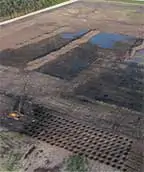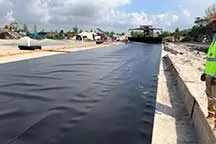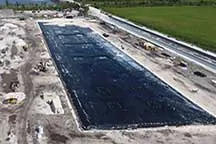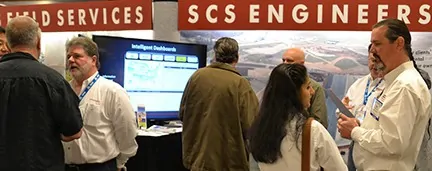

The commercial office sector in cities around the country is facing unprecedented challenges due to high vacancy rates that have been driven by factors including the work-from-home trend and the highest interest rates in almost 20 years. SCS Engineers worked with a panel of experts in the fields of economics, law, architecture, property development, and building sciences to explore the opportunities and challenges of the adaptive reuse of existing commercial buildings into new uses such as residential ones.
The resulting article provides valuable solutions and insight and can be found in Western Real Estate Business at this link: Western Real Estate Business April 2024 Page 20
SCS Engineers provides environmental consulting services for the real estate industry, including asbestos and lead-based paint surveys that are often needed before any building renovations or adaptive reuse. Once asbestos-containing materials or lead-based paint is identified at the building site, abatement activities to remove or mitigate the risks from these materials take place.
SCS monitors these abatement activities with air monitoring and inspections to make sure the removal is conducted according to regulations, and to protect workers and members of the surrounding community from exposure to these harmful chemicals; protecting and rehabilitating these spaces for re-occupancy.

Additional Information:
Meet SCS Engineers Environmental Professionals at the AEHS Foundation’s 39th Annual Conference on Soils, Sediments, Water, and Energy, October 16-19, in Amherst, Massachusetts.
This is AEHS’s “East Coast” environmental conference, and it brings together some 600-800 participants with diverse backgrounds, including representatives from state and federal agencies, environmental engineering firms, consulting companies, industry leaders, and esteemed academia — truly a gathering of the best and brightest minds in the field.
The conference delivers a robust and varied technical program with presentations on cutting-edge research, innovative approaches, and practical insights. The conference offers participants the opportunity to be part of a vibrant community dedicated to developing creative, cost-effective assessments and solutions to meet regulatory demands, shape a sustainable future, and make a lasting impact in the environmental field.
The Association for Environmental Health and Sciences Foundation, Inc. (AEHS) is a non-profit, member-supported, professional organization, with the purpose of facilitating communication and fostering cooperation among professionals concerned with the challenge of soil, sediment, and water assessment, cleanup, and protection.
We hope to see you there! For more conference details and registration information, click here
Meet and greet SCS professionals at the 2023 Florida Public Works Expo, April 18-20, at the Jacksonville River City Downtown Hotel and the Prime F. Osborn III Convention Center.
The Florida Public Works Expo attracts hundreds of Public Works professionals from the State of Florida and the Southeast, providing a great opportunity to network with your peers, boost your motivation, and gain powerful new tools for success! You will also have the opportunity to attend a variety of Technical Sessions designed to sharpen your skills, maximize production, and keep you on the cutting edge of emerging technologies and products. Be sure to visit the Trade Show and acquire new tools, tips, and techniques from the leading suppliers and manufacturers in your industry!
There are many great reasons to attend the Expo, including:
The event is hosted by the Florida Chapter of the American Public Works Association.
Click for details and registration information
Vapor intrusion is a regulatory hot button gaining traction on states’ radar nationwide. This is driven by a growing understanding of how vapors travel through the soil into structures, posing health risks to occupants, coupled with research showing volatile vapors can be problematic even at very low concentrations.
As in California, conservative assumptions by regulatory agencies call for careful due diligence during the assessment process. These salient concerns recently brought a real estate developer in Monrovia to seek a professional engineer.
The client plans to convert a commercial property to residential use. But before moving forward, it needs to assess potential environmental issues associated with the property. That’s where SCS comes in, drawing on its concrete knowledge base in geology and chemistry—and leveraging its grasp of regulatory requirements.
The work in Monrovia entails a detailed soil vapor assessment, looking for volatile organic compounds (VOCs); the discovery at this site came as little surprise to Julio Nuno, Senior Vice President, and Project Director, as these constituents are often found during evaluations of this kind.
Assessing for VOCs
In this case, the soil contained eight VOCs, some at non-compliant levels. The good news is, after an extensive, multi-step vetting process, Nuno and his team came up with a relatively inexpensive solution to tackle a potentially daunting problem.
“As part of the soil vapor assessment, we compare concentrations we find on-site to screening levels established by the Department of Toxic Substances Control. We often see levels in exceedance of regulatory thresholds, particularly in industrial areas with releases that can travel from groundwater to soil into the building through the slab,” Nuno says.
Most prominent at the Monrovia site were two chlorinated compounds that have been used as solvents in industrial applications: tetrachloroethylene, also called PCE, and trichloroethene, or TCE. PCE is commonly present in industrial settings and communities as drycleaners widely and routinely used the chemical for decades.
Nevertheless, the work begins even before confirming VOC levels and other specifics around these compounds. The first step is a Phase I Environmental Assessment looking to see if past use of the property or surrounding property may have left a significant environmental impact. The SCS team discovered the adjacent property had a release of VOCs they identified as a ‘recognized environmental condition,’ meaning it needs further evaluation using a Phase II to determine if vapors could migrate onto the client’s property.
During the Phase II Environmental Assessment –the collection of soil and soil vapor samples –the SCS team gets even more specific, determining what’s present, specific locations, what degree of contamination, and what these findings mean for redeveloping the property and its final use.
“We confirm subsurface concentrations and if they exceed state screening levels, and if the site represents a potential risk for future residential use. The information informs our possible solutions to mitigate any migration of certain VOCs into the building and the indoor air,” Nuno explains.
Redevelopment Goals – safety and cost containment
Safety comes first, but containing project costs is a priority, which comes down to knowing design options, how to piece components together with both function and economics in mind. At this site, achieving safety and controlling costs centered largely around looking at the mandatory infrastructure– a ventilation system for a planned underground parking garage to prevent accumulation of carbon monoxide and other vehicle exhaust emissions.
“We knew the underground parking would require a ventilation system. It makes sense to look at the parameters associated with that design to verify if it serves dual purposes to ventilate the garage and mitigate the potential for VOCs to enter the building,” Nuno says.
By studying air exchanges that would occur, the number of times replacing air-containing pollutants with cleaner air per hour, Nuno gets his answer. “We determined that a second, separate system would not be necessary for sufficient ventilation; the assessment enabled us to confirm vapors would not travel into the residential portion of the building.”
The client can save $50,000 to $75,000 in capital expenses upfront while achieving their safety goals and avoids ongoing operations and maintenance costs for added infrastructure.
An added layer of protection
Identifying the issues for site developers and their tenants, then plotting the best course of action to ensure safety and regulatory compliance takes experience and knowledge. SCS devises a soil monitoring plan, alerting developers of indications of potential contamination to the soil, of odor, or anything unusual that could suggest an environmentally adverse condition. The plan advises on how to respond should there be an unexpected condition adding a further protection layer.
“It’s essential that an engineer understand the applicable federal, state, and local standards for completing assessments, as well as understand regulatory stipulations. You must also know the variations in those stipulations to effectively design a sustainable plan,” Nuno says. “In Monrovia, we comply with the Department of Toxic Substances Control requirements, the requirements of the Los Angeles Regional Quality Control Board, and others. Each has specific stipulations for evaluating each contaminant. So, we stay on top of which rules apply to which location,” he says.
Nuno has submitted a draft report for review by his client and its legal counsel; he’ll meet with them to discuss findings and explain their meaning. SCS includes an executive summary, explaining in plain language what is salient; often, a backup report includes thousands of pages. “It’s a lot of complex information, so we work on the language,” Nuno says.
“It’s important to paint an accurate picture and use terms that all parties, whether the client, investors, or other stakeholders understand. These redevelopments are major projects with many due diligence considerations. We want to provide accurate findings and recommendations that the client and their advisors can digest to help them with their decision making.”
More resources:
As large tracts of geographically desirable vacant land become scarcer, residential and commercial property developers are increasingly turning to old landfills or former dumps. However, such redevelopment is complex and rife with uncertainties. When compared to greenfield development, the land acquisition costs are lower. Still, any savings are typically offset by greater environmental and infrastructure costs associated with the foundation, landfill gas management, stormwater management, groundwater impacts, meeting closure requirements, and multiple regulatory agency coordination. Therefore, it is important to maximize the developable area while providing engineering solutions to make the project economically feasible. In this blog, we identify some options to reuse challenging sites and lessons learned to contribute to successful redevelopment projects.

Deep Dynamic Compaction
Old landfills or dumps present some unique soil stability challenges. Deep dynamic compaction (DDC) is a ground stabilization technique that has gained popularity in recent years to improve subsurface soil conditions. DDC involves dropping 6 to 30-ton weights from a height between 30 and 75 feet to achieve the desired soil compaction. DDC can effectively apply to a range of subsurface materials, including former C&D debris or municipal solid waste dumps.
DDC provides a stable foundation for future development, minimizes differential settlement while leaving the landfill waste in place, and eliminates the costs associated with removing, transporting, and disposing of buried waste, costing millions of dollars. For simplicity’s sake, let’s consider a 1-acre old landfill or a dumpsite with an average of 15 feet of waste. If excavating the waste and replacing it with clean fill, the disposal fee costs for the excavated waste alone could exceed $400,000. Alternatively, DDC costs range from $1.50 to $2.00 per square foot or $65,000 to $87,120 per acre, excluding mobilization, which costs around $30,000.

Gas Mitigation Systems
Constructing buildings on top of dynamically compacted areas generally requires a combustible gas barrier layer below the building foundation to manage subsurface combustible gases (typically methane). The barrier is required because the waste remains in place. In its simplified form, gas mitigation systems include:

These gas mitigation systems can be either a passive or an active system with a blower. The cost of such systems varies depending on the size of the building, location, and type of liner system used. Typical capital costs for passive systems are in the range of $7 to $9 per square foot for the spray-applied liner and $3 to $4 per square foot for the HDPE liner. For an active system using blowers, add $3 to $4 per square foot. The designer configures a system from these options to address the client’s risk preference and considering future tenant preferences.
Using innovative approaches, impaired lands are increasingly attractive to developers. Beyond the cost-saving benefits to developers realized through DDC and an appropriate gas mitigation system, such projects also create local jobs, increase the tax base, and protect public health and the environment.
About the Authors:

Perfluoroalkyl and polyfluroalkyl substances (PFAS) and other emerging contaminants are becoming increasingly important for real estate transactions. Several states have adopted or proposed health guidelines or Maximum Contaminant Levels (MCLs) for PFAS in their state. States with adopted limits include CA, CT, CO, MN, NC, NH, NJ, and VT; and states with proposed limits include IL, MA, MI, and NY. You can track bills by state here.
The Wisconsin Department of Natural Resources (WDNR) and the Environmental Protection Agency (EPA) are focusing their attention on these contaminants. The WDNR recently issued letters to more than 3,000 responsible parties listed with open cases on the DNR’s Bureau for Remediation and Redevelopment Tracking System (BRRTS) requesting they review PFAS use at open sites. Read a sample of the DNR letter.
With WDNR’s increasing focus on PFAS, a lack of sufficient due diligence, which includes evaluations for PFAS, could lead to significant additional liability for property purchasers, developers, and lenders. In addition, a lack of sufficient assessment could lead to a delay in case closure even after responsible parties have addressed all other contaminants and potential exposure pathways at a site. A sufficient assessment for PFAS will depend on site-specific factors and should carefully consider the associated risks and liabilities.
For real estate buyers, owners, developers, lenders, brokers, and contractors the potential presence of PFAS at a property presents significant liabilities that need to be incorporated into due diligence procedures and safe work plans. The investigation and remediation of sites with PFAS contamination can be expensive, and the WDNR is working to define enforceable cleanup goals for soil and groundwater.
Resources:
About PFAS
PFAS are often referred to as “forever chemicals” due to their inability to be broken down in the environment. Due to the very high toxicity of PFAS, the proposed groundwater standard is extremely low – in the parts per trillion, which is more than 100 times lower than the groundwater standards for other well-known toxic contaminants such as benzene from gasoline or tetrachloroethylene commonly used at dry cleaners and industrial facilities.
PFAS are found in a wide variety of products, including nonstick coatings (e.g., Teflon), water-repellent coatings used on clothing and food packaging, fume suppressants, and firefighting foams. Potential sources of PFAS include many types of manufacturing and processing facilities, locations where firefighting foams have been used, metal plating facilities, wastewater treatment plants, and many more.
PFAS systems can treat and clean sources and remediation solutions by environmental engineers can bring properties back to life; safe to build and live on.
SCS Engineers ranks 4th on the Los Angeles Business Journal’s list of the top 25 largest environmental services firms in the Los Angeles region. “We’re very proud of our environmental work in California and across the nation,“ stated Pat Sullivan, BCES, CPP, REPA, and a Senior Vice President of SCS Engineers. “It’s especially rewarding to know that we make a positive difference in our backyard and for the regional economy.”
See the Los Angeles Business Journal List
SCS Engineers – highly ranked for environmental consulting – San Diego Business Journal

The San Diego Business Journal listed SCS Engineers as one of the top Environmental Consultants in the region. The listing was researched and compiled by Courtney Shamrell of SDBJ. Environmental services covered by the list include; site assessments, environmental sciences, NEPA/CEQA activities, environmental remediation, work for federal and local governments, work for commercial enterprises, and other environmental engineering projects.
Thank you to our clients and to our environmental professionals who put SCS sustainable environmental solutions to work.